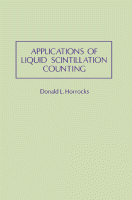Browse content
Table of contents
Actions for selected chapters
- Full text access
- Book chapterNo access
CHAPTER I - INTRODUCTION
Pages 1-11 - Book chapterNo access
CHAPTER II - BASIC PROCESSES
Pages 12-34 - Book chapterNo access
CHAPTER III - SCINTILLATOR SOLUTIONS
Pages 35-68 - Book chapterNo access
CHAPTER IV - LIQUID SCINTILLATION COUNTERS AND MULTIPLIER PHOTOTUBES
Pages 69-89 - Book chapterNo access
CHAPTER V - PARTICLE COUNTING TECHNIQUES
Pages 90-144 - Book chapterNo access
CHAPTER VI - PREPARATION OF COUNTING SAMPLES
Pages 145-174 - Book chapterNo access
CHAPTER VII - OXIDATION TECHNIQUES
Pages 175-187 - Book chapterNo access
CHAPTER VIII - COUNTING VIALS
Pages 188-197 - Book chapterNo access
CHAPTER IX - BACKGROUND
Pages 198-207 - Book chapterNo access
CHAPTER X - QUENCH CORRECTION METHODS
Pages 208-226 - Book chapterNo access
CHAPTER XI - DUAL-LABELED COUNTING
Pages 227-237 - Book chapterNo access
CHAPTER XII - CHEMILUMINESCENCE AND BIOLUMINESCENCE
Pages 238-257 - Book chapterNo access
CHAPTER XIII - RADIOIMMUNO ASSAY (RIA)
Pages 258-262 - Book chapterNo access
CHAPTER XIV - CERENKOV COUNTING
Pages 263-275 - Book chapterNo access
CHAPTER XV - PULSE SHAPE DISCRIMINATION
Pages 276-289 - Book chapterNo access
CHAPTER XVI - FLOW CELL COUNTING
Pages 290-297 - Book chapterNo access
CHAPTER XVII - LARGE-VOLUME COUNTERS
Pages 298-305 - Book chapterNo access
CHAPTER XVIII - STATISTICAL CONSIDERATIONS
Pages 306-331 - Book chapterNo access
AUTHOR INDEX
Pages 333-339 - Book chapterNo access
SUBJECT INDEX
Pages 340-346
About the book
Description
Applications of Liquid Scintillation Counting deals with liquid scintillation counting and its applications in fields such as the biosciences, medicine, environmental and space sciences, chemistry, and physics. These applications include dual-labeled counting; Cerenkov counting; radioimmunoassay, chemiluminescence and bioluminescence; pulse shape discrimination; flow cell counting; and large-volume counters. This book is comprised of 18 chapters and begins with a historical overview of the liquid scintillation method, the first liquid scintillation counters, and early scintillator solutes. The following chapters focus on the theory of liquid scintillation counting; the components of the liquid scintillator solution; and the development of the liquid scintillation counter and multiplier phototubes. The discussion then turns to the detection and measurement of different types of particles produced by radionuclides using liquid scintillation techniques; the techniques and problems of sample preparations (homogeneous and heterogeneous); oxidation techniques; and importance and difference of several types of counting vials. The sources of quenching in counting samples and methods of monitoring and correction for variable quench within samples are also considered. Several special applications of liquid scintillation techniques are presented, including dual-labeled counting, radioimmunoassay, and flow cell counting. In conclusion, the statistical considerations involved in determining the reliability and accuracy of data obtained by nuclear counting techniques are highlighted. This monograph will serve as a reliable source of information for those who are already using or starting to use liquid scintillation counting techniques.
Applications of Liquid Scintillation Counting deals with liquid scintillation counting and its applications in fields such as the biosciences, medicine, environmental and space sciences, chemistry, and physics. These applications include dual-labeled counting; Cerenkov counting; radioimmunoassay, chemiluminescence and bioluminescence; pulse shape discrimination; flow cell counting; and large-volume counters. This book is comprised of 18 chapters and begins with a historical overview of the liquid scintillation method, the first liquid scintillation counters, and early scintillator solutes. The following chapters focus on the theory of liquid scintillation counting; the components of the liquid scintillator solution; and the development of the liquid scintillation counter and multiplier phototubes. The discussion then turns to the detection and measurement of different types of particles produced by radionuclides using liquid scintillation techniques; the techniques and problems of sample preparations (homogeneous and heterogeneous); oxidation techniques; and importance and difference of several types of counting vials. The sources of quenching in counting samples and methods of monitoring and correction for variable quench within samples are also considered. Several special applications of liquid scintillation techniques are presented, including dual-labeled counting, radioimmunoassay, and flow cell counting. In conclusion, the statistical considerations involved in determining the reliability and accuracy of data obtained by nuclear counting techniques are highlighted. This monograph will serve as a reliable source of information for those who are already using or starting to use liquid scintillation counting techniques.
Details
ISBN
978-0-12-356240-1
Language
English
Published
1974
Copyright
Copyright © 1974 Elsevier Inc. All rights reserved.
Imprint
Academic Press
